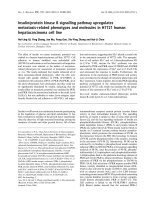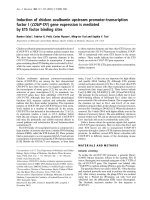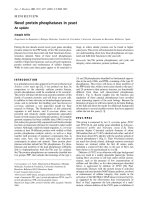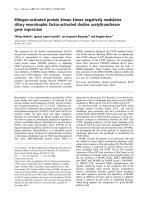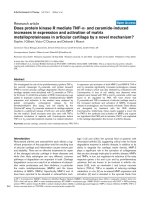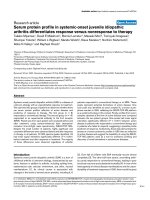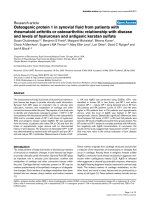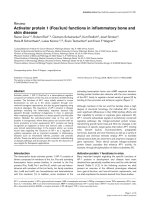Báo cáo Y học: Mitogen-activated protein kinase kinase negatively modulates ciliary neurotrophic factor-activated choline acetyltransferase gene expression pdf
Bạn đang xem bản rút gọn của tài liệu. Xem và tải ngay bản đầy đủ của tài liệu tại đây (280.48 KB, 9 trang )
Mitogen-activated protein kinase kinase negatively modulates
ciliary neurotrophic factor-activated choline acetyltransferase
gene expression
Tiffany Mellott
1
, Ignacio Lopez-Coviella
2
, Jan Krzysztof Blusztajn
1,2
and Brygida Berse
1
1
Department of Pathology and Laboratory Medicine and
2
Department of Psychiatry, Boston University School of Medicine;
Boston, MA, USA
The expression of t he c holine acetyltransferase ( ChAT)
enzyme that synthesizes the neurotransmitter acetylcholine
(ACh) is upregulated by ciliary neurotrophic factor
(CNTF). We s tudied the involvement of the mitogen -acti-
vated protein kinase (MAPK) pathway in regulating
ChAT expression in a murine septal cell line. Surprisingly,
we found that PD98059 and U0126, two structurally dis-
tinct inhibitors of MAPK kinase (MEK1), increased both
basal and CNTF-induced ACh p roduction. Transien t
transfections with ChAT promoter-luciferase reporter
construct demonstrated synergy between PD98059 and
CNTF at the transcriptional level. Moreover, in cotrans-
fection studies, overexpression of constitutively activated
MEK1 completely abrogated the CNTF-mediated induc-
tion of the reporter. Blocking MEK1 did not signi®cantly
alter CNTF-induced Tyr705 phosphorylation of the prin-
cipal mediator of the CNTF pathway, the transcription
factor Stat3. However, PD98059 inhibited Ser727 phos-
phorylation of Stat3, demonstrating that the latter is
MEK1-dependent. Taken together, these results i ndicate
that activation of the MEK1/MAPK pathway inhibits the
CNTF-mediated stimulation o f C hAT exp ression, possibly
as a p art of a feedback mechanism.
Keywords: acetylcholine; choline acetyltransferase; MAP
kinase; c iliary neurotrophic factor; Stat3.
Biosynthesis o f the neurotransmitter acetylcholine (ACh)
from choline and acetyl coenzyme A is catalyzed by the
enzyme choline acetyltransferase (ChAT, acetyl-CoA:cho-
line O-acetylotransfe rase, EC 2.3.1.6) [1]. Following syn-
thesis, ACh is transported into synaptic vesicles by vesicular
acetylcholine transporter (VAChT). ChAT and VAChT are
encoded within one gene locus and share regulatory
elements for transcription [2]. Recent studies have shown
that the two genes are coordinately regulated in response to
various extracellular factors, including nerve growth factor
(NGF) and ciliary neurotrophic factor (CNTF) [3±10].
Signal transduction pathways involved in this regulation are
largely unknown. Quirin-Stricker et al. identi®ed s everal
transcription factors involved in transcriptional activation
of the human cholinergic locus by NGF and demonstrated
that cyclic AMP-dependent protein kinase (PKA) is
important fo r this process [11]. Recently, it was shown that
regulation of the rat cholinergic gene locus by cyclic AMP is
mediated by PKA type II, but not by PKA type I [12].
In a previous study, we demonstrated that NGF, acting
through receptor t yrosine kinase TrkA, can activate
cholinergic gene e xpression and ACh production in the
murine septal cell line SN56T17 [9]. At the same time, NGF
downregulates the CNTF-induced increases in ACh pro-
duction, pointing to interference between the NGF and
CNTF signaling pathways. As the major signaling event
evoked by NGF in many cell types, including SN56T17, is
the activation of mitogen-activated p rotein kinase (MAPK),
we investigated the role of this pathway in regulating the
cholinergic phenotype and speci®cally in modulating the
CNTF effect.
MAPK cascades are present in all eukaryotic cells and
are utilized in many signal transduction pathways origi-
nating from receptors at the cell s urface [13]. The Ras/Raf/
ERK pathway is activated by growth factors and cyto-
kines, including NGF and CNTF [14,15]. The transient
formation of Ras-GTP and activation of R af kinase at the
cell membrane eventually leads to the phosphorylation of
the two members of MAPK family, ERK1 (p44MAPK)
and ERK2 (p42 MAPK) b y MAPK kinase 1 (MAPKK1
or MEK1) [14]. Activated ERKs phosphorylate and
regulate numerous targets in the cytoplasm and in the
nucleus, including other protein kinases, transcription
factors, cytoskeletal proteins, g rowth factor r eceptors,
and other regulatory proteins [13]. Speci®city of MAPK
effects in different cell types and in response to different
stimuli is achieved by the action of scaffolding proteins,
which bring together the components of a given MAPK
pathway [16].
Correspondence t o B. Berse, Department of Pathology and Laboratory
Medicine, Boston University School of Medicine, 85 East Newton
Street, Room M1006, Boston, MA 02118, USA.
Fax: + 1 617 638 5400, Tel.: + 1 617 638 5960,
E-mail:
Abbreviations: ACh, acetylcholine; ChAT, choline acetyltransferase;
CNTF, ciliary neurotrophic factor; DMEM, Dulbecco's modi®ed
Eagle's medium; ERK, extracellular signal-regulated kinase; JAK,
Janus kinase; LIF, leukemia inhibitory factor; MAPK, mitogen-acti-
vated protein kinase; MEK, mitogen-activated protein kinase kinase;
NGF, nerve growth factor; PKA, cyclic AMP-activated protein kin-
ase; STAT, signal transducer and activator of transcription; VAChT,
vesicular acetylcholine transporter; VIP, vasoactive intestinal peptide.
(Received 6 June 2001, revised 12 November 2001, accepted 30
November 2001)
Eur. J. Biochem. 269, 850±858 (2002) Ó FEBS 2002
In this study we employed two distinct noncompetitive
MEK1 inhibitors to prevent the phosphorylation of MAPK
by MEK1 in SN56T17 cells. We report that inhibiting the
MEK1/MAPK pathway increases both basal and CNTF-
induced ACh synthesis and ChAT promoter activity in
SN56T17 cells. Moreover, introducing constitutively active
MEK1 into the c ells by transient transfection abrogates the
stimulatory effect of CNTF. Experiments with the JAK/
STAT pathway inhibitor tyrphostin AG490 suggest that
CNTF-induced ACh production is JAK/STAT dependent.
Blocking MAPK does not signi®cantly in¯uence tyrosine
phosphorylation of the transcription factor Stat3 evoked by
CNTF, but it reduces its serine phosphorylation. We
propose that the MEK1/MAPK cascade negatively regu-
lates ACh synthesis, possibly as a part of a feedback
mechanism.
EXPERIMENTAL PROCEDURES
Materials
PD98059 was obtained from Calbiochem-Novabiochem
(La Jolla, CA, USA). U0126, luciferase reporter vector
pGL3-Basic, and Luciferase Assay System were from
Promega (Madison, WI, USA). The expression plasmid
pUSE-MEK1(activated), as well as the control v ector
pUSE were obtained from Upstate Biotechnology (Lak e
Placid, NY, USA). CNTF was purchased from R & D
Systems (Minneapolis, MN, USA) and Pepro Tech Inc.
(Rocky Hill, NJ, USA). Fetal bovine serum, N2
supplement, and LipofectAMINE were obtained from
Gibco BRL (Bethesda, MD, USA). Polyclonal anti-
ChAT Ig AB144P and AB143 were purchased from
Chemicon (Temecula, CA, USA), and all other antibod-
ies [anti-(phospho p44/42 MAPK) Ig, anti-Stat3 Ig, anti-
(phosphoSer727 Stat3) Ig, anti-(phosphoTyr705 Stat3) Ig]
were from New England Biolabs (Beverly, MA, USA).
Immobilon P membrane for Western blotting was from
Millipore (Bedford, MA, USA). Renaissance reagent for
chemiluminescence was obtained from N ew England
Nuclear (Boston, MA, USA). Sigma Chemical Co.
(St Louis, MO, USA) supplied all other chemicals and
reagents.
Cell culture and treatments
The mouse septal cell line SN56 (generously provided by
B.H.Wainer,UniversityofChicago,IL,USA),isa
product of the fusion of septal neurons from postnatal
day 21 mice with murine neuroblastoma N18TG2. The
SN56T17 cell line was obtained by stable transfection of
SN56 cells with rat trkA cDNA [9]. Both cell lines were
maintained at 37 °C in an atmosphere of 95% air, 5%
CO
2
in Dulbec co's modi®ed Eagle's medium (DMEM)
containing 1 m
M
pyruvate and 10% fetal bovine serum.
LA-N-2 cells (a generous gift from R. Seeger, University
of California, LA, USA) were grown in Leibowitz L-15
medium containing 10% fetal bovine serum at 37 °Cin
an atmosphere of 100% air. During treatment periods
with test compounds, cells were grown in DMEM
containing N2 supplement [17] instead of fetal bovine
serum, and the medium was changed every 24 h.
Acetylcholine measurements
The intracellular ACh content was measured by HP LC as
described in Berse et al. [9], except 50 l
M
neostigmine was
used in the physiological salt solution.
Western blotting and immunoprecipitation
For Western analysis, cell extracts were prepared by adding
lysis buffer (50 m
M
Tris pH 7.5, 150 m
M
NaCl, 1%
Nonidet NP-40, 10% glycerol, 2 m
M
4-(2-aminoethyl)-
benzenesulfonyl ¯uoride, 1 lgámL
)1
leupeptin, 2 lgámL
)1
aprotinin, 2 lgámL
)1
pepstatin) to a 60-mm culture dish,
scraping the cells into a tube, mixing, incubating for 15 min
on ice, and brie¯y centrifuging to clear. The extracts were
normalized for total protein content and separated by SDS/
PAGE. After blotting, membranes were blocked u sing 5%
nonfat milk in a NaCl/P
i
/Tween solution pH 7.4 (contain-
ing 140 m
M
NaCl, 3 m
M
KCl, 10 m
M
Na
2
HPO
4
,2m
M
KH
2
PO
4
, 0.15% Tween 20). The primary antibodies were
used at the dilutions recommended by the manufacturers.
The antibody±antigen complexes were detected with anti-
(rabbit IgG) Ig peroxidase conjugates and visualized using
the chemiluminescence method and Kodak X-Omat AR
®lm. Band intensities were quanti®ed with a d ensitometric
scanner and NIH
IMAGE
or Molecular Dynamics
IMAGE-
QUANT NT
software.
For immunoprecipitation, cell lysates were prepared as
described above. Cell extracts were incubated overnight
with either polyclonal anti-ChAT Ig AB144P (2 lgper
500 lg of extract) or polyclonal anti-Stat3 Ig (1.5 lgper
500 lg of extract) and protein A Sepharose (3.5 mg
per sample) in a rotary mixer at 4 °C. Samples were brie¯y
centrifuged and washed three times. The pellet was resus-
pended in lysis buffer and proteins were electrophoretically
separated by SDS/PAGE.
Reporter gene assay
The ChAT±luciferase reporter construct has been described
previously [18]. Brie¯y, a 4.8-kb XhoI±HindIII portion of
the ChAT promoter region was excised from a 6.4-kb clone
of mouse genomic DNA (GenBank accession no.
AF019045) [19,20], kindly provided by J. Naciff (University
of Cincinnati College of Medicine, Cincinnati, OH, USA).
The 4.8-kb fragment stretches from position )4817 (relative
to the ChAT translation start) to position +46, and
contains the proximal N and M promoters of the ChAT
gene. It was inserted between the XhoIandHindIII sites
upstream of the luciferase coding region of the vector pGL3-
Basic. For cotransfection studies, the luciferase construct
was used together with the pUSE-based expression plasmid
containing rat MEK1 cDNA under the control of the CMV
promoter. MEK1 cDNA in this construct carries mutations
substituting two regulatory serine residues with aspartic
acid, which results in constitutive kinase activity. SN56T17
cells were transfected using LipofectAMINE in serum-free
DMEM. Three to four hours after transfection, the medium
was replaced with DMEM containing 10% fetal bovine
serum and the test compounds. The cells were treated for
48 h (with one medium change) and lucife rase activity was
measured with the Luciferase Assay System, according to
Ó FEBS 2002 MEK1 pathway inhibits cholinergic gene expression (Eur. J. Biochem. 269) 851
the manufacturer's protocol. Light intensity was measured
in the Lumat LB 9501 semiautomatic luminometer (EG &
G Berthold, Bad Wildbad, Germany), and expressed in
arbitrary units.
Statistical analysis
One- or two-way analysis of variance, as appropriate, and
Tukey's test were performed with the help of
SYSTAT
statistical software (SPSS Inc., Chicago, IL, USA) using
Macintosh computers.
RESULTS
To address the relationship between MAPK activation and
ACh synthesis, we used PD98059, a speci®c MEK1
inhibitor [21]. It has been previously shown that PD98059
decreases ERK1 (p44) and ERK2 (p42) activation (mea-
sured as the degree of threonine/tyrosine phosphorylation)
in a variety of cell lines following short incubations with the
inhibitor [21,22]. First we tested the inhibitor's effectiveness
at blocking basal and CNTF-enhanced MAPK phospho-
rylation in our model septal cell line SN56T17. We probed
Western blots with an antibody that recognizes the ERK1
and ERK2 only when phosphorylated on Tyr and Thr
residues. The basal level of phosphorylated ERK1 and
ERK2 in SN56T17 cells is easily detectable with this
antibody. Incubation with CNTF fo r 15 min increased the
level of phosp horylate d ERK1/2 by 40% (Fig. 1A). In
similar experiments, we determined that treatment with
CNTF for time periods up to 30 min increased ERK1/2
phosphorylation in these cells up to twofold (data not
shown). Pretreatment with 10 l
M
PD98059 for 15 min
almost completely obliterated MAPK phosphorylation in
both CNTF-treated and untreated cells (Fig. 1A). Our
results are in agreement with those of Bartoe & Nathanson,
who also observed a high level of basal MAPK activation in
SN56 cells that could be further stimulated about twofold
by a related cytokine, leukemia inhibitory factor (LIF) [23].
Both basal and LIF-stimulated MAPK activity could be
eliminated by PD98059 [23].
We then investigated whether th e downregulation of
MAPK phosphorylation was maintained following an
extended treatment with PD98059. When SN56T17 cells
were cultured in the presence of the inhibitor for 48 h, a
decrease of up to 70% in MAPK phosphorylation level was
visualized by immunoblotting (Figs 1 B,C). After protracted
serum withdrawal in a nonsupplemented medium, the basal
MAPK phosphorylation level was greatly reduced and a 30-
min treatment with CNTF resulted in an eightfold induction
of MAPK phosphorylation, which was almost completely
prevented by pretreatment w ith the in hibitor (Fig. 1B). In
cells grown in N2-supplemented medium in the presence of
CNTF for 48 h, there was no signi®cant difference in
MAPK phosphorylation between control and CNTF-
treated cells, and PD98059 again decreased MAPK activa-
tion by 50±70%. Factors present in serum and insulin in the
N2-supplemented medium could be responsible for the
residual MAPK activation, since MAPK phosphorylation
is completely eliminated in these cells following a prolonged
incubation with PD98059 in a nonsupplemented medium
(data not shown).
In order to investigate the role of MEK1/MAPK
pathway in ACh synthesis, we ®rst measured the effect of
inhibiting this pathway on the intracellular ACh level. We
examined the SN56T17 cells and their parental cell line
SN56, as well as the human neuroblastoma cell line LA-N-2.
In order to rule out unspeci®c effects of PD98059, we also
tested another noncompetitive MEK1 inhibitor, U0126.
The two compounds are structurally unrelated, although it
remains unclear if they share a common binding site on
MEK1 [24]. Both inhibitors are highly speci®c to the
MEK1/2/ERK pathway, as they do not affect other MAPK
pathways MEKK1-3, MKK4/JNK, or MKK6/p38, or
numerous other protein kinases tested [22,24,25]. In each
cell line, there was a statistically signi®cant effect of both
MEK1 inhibitors on ACh production as compared to con-
trols, and both inhibitors were equally effective (Fig. 2A).
The effect of the inhibitors on LA-N-2 cells was smaller than
on the mouse cell lines, probably because of lower basal
MAPK activity in LA-N-2 cells as compare d to SN56 cells
(data not shown). A time-course study revealed that 10 l
M
A
C
PD
PD/CNTF
CNTF
p44
p42
B
Control
Control
CNTF
PD
PD/CNTF
p44
p42
p44
p42
PD
CNTF
−
+
−
−
+
+
0’
0’15’
15’
5’
5’
Fig. 1. Eect of PD98059 on MAP k inase phosphorylation in SN56T17 cells. (A) The cells were serum-sta rved for 3 h, pretreated with 10 l
M
PD98059 for 1 5 min, and then treated with 20 ngámL
)1
CNTF for the indicated periods of time. Cell lysates (40 lg per lane) were analyzed by
Western blotting with an antibody speci®c to doubly ph osphorylated forms of ERK1 (p44) and ERK2 (p42). The results are representative of two
experiments. (B) The cells were grown for 48 h either in the presence or in the absence of 10 l
M
PD98059 (PD), serum-starved for 6 h, and then
treated with 20 ngámL
)1
CNTF for 30 min Western blotting was performed as d escribed in (A). T he results are representative of two experiments.
(C) The cells were grown for 48 h either in the presence or in the absence of 10 l
M
PD98059 (PD), 20 ngámL
)1
CNTF, or both. Western blotting
was performed as described in ( A). The results are representative of four experiments.
852 T. Mellott et al. (Eur. J. Biochem. 269) Ó FEBS 2002
PD98059 produced a twofold increase in ACh levels in
SN56T17 cells and that the full effect could be observed
after 48 h of treatment (Fig. 2B). Following a 48-h treat-
ment, PD98059 increased the intracellular levels of ACh in
SN56T17 cells in a concentration-dependent and saturable
manner ( Fig. 2C), with an EC
50
of 3.7 l
M
, comparable to
the reported IC
50
of 4 l
M
on MEK1 activity in vitro [21,22].
Thus, these data suggest that the increase in intracellular
ACh levels is a result of down-regulating MEK1-mediated
MAPK activation.
Because our previous studies have shown that CNTF
upregulates the cholinergic phenotype and that NGF
strongly activates MAPK in SN56T17 cells while interfering
with the actions of CNTF [5,9], we examined the effect of
PD98059 and U0126 on the ability of CNTF to increase
ACh synthesis. The results are presented in Fig. 3A.
Consistent with our previous ®ndings, CNTF alone signi-
®cantly increased intracellular ACh level by more than
threefold. PD98059 increased ACh level by twofold, while
the combined treatment with CNTF and PD98059
increased ACh content by sixfold. Substituting U0126 for
PD98059 resulted in a similar effect on CNTF-stimulated
ACh production. Similar results were obtained with SN56
and L A-N-2 c ells (data not shown). This i ncrease in
intracellular ACh levels was the result of an increased
amount of ChAT protein, as demonstrated by immunopre-
cipitation followed by Western blotting with two polyclonal
anti-ChAT Ig (Fig. 3B). We measured ChAT protein in
SN56T17 cells which had been treated w ith PD98059
(10 l
M
), CNTF (20 ngámL
)1
), or the combination for 48 h.
Both PD98059 and CNTF increased ChAT protein levels,
and the combined treatment with PD98059 and CNTF had
the greatest effect on the level of C hAT protein (Fig. 2B).
In summary, both PD98059 and CNTF are able to increase
intracellular ACh levels via increasing ChAT p rotein levels.
Furthermore, even though the MAPK signaling is required
for CNTF-mediated activation of certain genes i n the CNS
[26], in this case, blocking MAPK activation enhances the
CNTF effect on ACh p roduction.
C
Acetylcholine, pmol/mg protein
0510 15 20
Concentration of PD98059, µ
M
1200
1000
800
600
0
EC
50
= 3.7 µM
B
0
50
100
150
200
0 2 4 7
Time, hours
Acetylcholine, % Control
A
0
50
100
150
200
250
Control PD U Control PD U Control PD U
Acetylcholine, % Control
Fig. 2. MEK1 inhibitors increase ACh production in cholinergic cell lines. (A) SN56T17, SN56, and LA-N-2 cells were grown for 48 h in the presence
or absence of 10 l
M
PD98059 (PD) or 10 l
M
U0126 (U). Intracellular A Ch was measured in cell extrac ts as described in Experimental proce dures.
The results are presented as means SEM o f two experiments, each performed in quadruplicate. Acetylcholine levels in cells treated with PD98059
and U0126 were statistically dierent from control values for each cell line (SN56T17 P < 0.0 01 and P < 0.005, respectively; SN56 P < 0.001
and P < 0.001, respectively; and LA-N-2 P <0.01andP < 0 .01, respectively), and were not statistically dierent from each other (SN6T17
P 0.834; SN56 P 0.765; and LA-N-2 P 0.977); Tukey's test. (B) Time Course: the SN56T17 cells were grown for 24, 48 or 72 h in the
presence or absence of the MEK inhibitor PD98059 (10 l
M
). The results are presented as means SEM and are representative of three
experiments. (C) Concentration-response curve of PD98059: the SN56T17 cells were treated for 48 h in the presence of various PD98059
concentrations (0, 1, 3, 5, 10, 15, and 20 l
M
). The dat a are representative of three experiments. A rectangular hyperbola was ®tted to the data,
permitting the estimation of the median eective concentration (EC
50
3.7 l
M
).
A
Control PD CNTF PD/CNTF UU/CNTF
0
200
400
600
800
Acetylcholine, % Control
ChAT
CNTF
PD/CNTF
Control
PD
B
Fig. 3. Up-regulation of the cholinergic phenotype by CNTF and MEK
inhibitors. The SN56T17 cells were grown for 48 h in the presence or
absence of 10 l
M
PD98059 (PD), 10 l
M
U0126 (U), 20 ngámL
)1
CNTF, or combinations. (A) MEK inhibitors and CNTF increase
intracellular ACh levels. Intracellular ACh was measured in cell
extracts as described in the Experimental procedures. The results are
presented as means S EM of 12 samples (four experiments, each
performed in t riplicate). Two-way analysis of variance revealed a sig-
ni®cant eect of PD98059 (P < 0.001), U0126 (P < 0.005), and
CNTF (P < 0.001), and a signi®cant interaction between PD98059
and CNTF (P < 0.05) and between U0126 and CNTF (P <0.01).
(B) ChAT protein levels are increased following PD98059 and CNTF
treatment. Cell lysates (250 lg per sample) were immunoprecipitated
with anti-ChAT Ig AB144P, and then analyzed by Western blotting
using anti-ChAT Ig AB143. Similar results were obtained in four
additional experiments.
Ó FEBS 2002 MEK1 pathway inhibits cholinergic gene expression (Eur. J. Biochem. 269) 853
In order to examine w hether the effect of MAPK on the
cholinergic phenotype involves changes in gene expression,
we employed transient transfection assays to measure the
activation of the ChAT promoter by PD98059 and CNTF.
We used a ChAT±luciferase construct containing the
proximal mouse ChAT promoter region linked to a
luciferase reporter gene as described previously [18].
Following transfection with the reporter construct,
SN56T17 cells were treated with PD98059, CNTF, or both,
for 48 h and assayed for luciferase reporter activity (Fig. 4).
Luciferase activity increased fourfold following CNTF
treatment and twofold with PD98059. Substituting U0126
for PD98059 resulted in a similar effect on luciferase activity
(data not shown). Moreover, there was a substantial
synergistic increase i n luciferase activity (by 20-fold) when
both PD98059 and CNTF were employed (Fig. 4B). This
result suggested that the MEK1/MAPK pathway interferes
with the CNTF pathway and that inactivation of the former
is necessary to observe the full CNTF effect on the ChAT
promoter. We tested this hypothesis directly in the cotrans-
fection experiments using the expression vector pUSE with
a cDNA insert producing constitutively active MEK1.
When this plasmid was cotransfected into SN56T17 cells
together with the luciferase reporter construct, the effect of
CNTF on the luciferase expression was completely abro-
gated, whereas c otransfection with the empty pUSE vector
did not inhibit C NTF-induced luciferase expression
(Fig. 4 C). Thus, we conclude that the MEK1 pathway
interferes with the CNTF action in cholinergic cells.
The m ain signaling pathway utilized by CNTF involves
activation of transcription factors of the STAT (signal
transducers and activators of transcription) family. Upon
CNTF binding, the CNTF receptor/Janus protein tyrosine
kinase (Jak) 2 complex preferentially phosphorylates Stat3
at residue Tyr705 [27]. We veri®ed the involvement of the
Jak2/Stat3 pathway in regulating ACh synthesis using the
Jak2 inhibitor tyrphostin AG490. This compound has been
shown to be selective for JAK family kinases [28]. Although
AG490 at higher concentrations inhibits Jak3 in lympho-
cytes [29], its primary speci®c target in most cell types is the
Jak2/Stat3 pathway [28,30,31]. We used the inhibitor at
10 l
M
, the concentration at which it is speci®c for JAK
kinases in vitro and signi®cantly reduces the DNA binding
activity of Stat3 in vivo [32]. First, we tested the ability of the
inhibitor to block the Jak2/Stat3 pathway in SN56T17 cells.
Following a 15-min exposure to 10 l
M
AG490, CNTF-
induced Tyr705 phosphorylation of Stat3 was signi®cantly
reduced (Fig. 5A). After the cells were treated for 48 h with
the inhibitor, either alone or in combination with CNTF,
intracellular ACh levels were measured as described above
(Fig. 5 B). Tyrphostin AG490 alone had no effect on basal
ACh synthesis; however, it reduced CNTF-stimulated ACh
A
13 more ChAT
coding exons
first ChAT
coding exon
polyA
site
ATG (Met)
ATG (Met)
V1
V2
R promoter
ChAT N
promoter
ChAT M
promoter
Luciferase reporter
4.8-kb ChAT genomic DNA
pGL3Basic
VAChT ORF
HinDIII
XhoI
0
5 10 15 20
PD/CNTF
CNTF
PD
Control
B
ChAT-Luc + MEK1
ChAT-Luc + Vector
ChAT-Luc
Luciferase Activity, arbitrary units
Luciferase Activity, arbitrary units
00.5 11.5 22.5 3
Control
CNTF
C
Fig. 4. MEK1 interferes with the up-regulation of ChAT promoter activity by CNTF in a reporter gene assay. (A) ChAT±luciferase reporter construct.
The diagram illustrates the lo calization of the promoter region used in th e construct with in the cholinergic locus. The positions of the distal R
promoter, as we ll as V AChT-spe ci®c V1 and V2 promoters and ChAT-speci®c N and M p romoters are marked with horizontal arrows. ORF, open
reading frame. (B) SN 56T17 cells were transfected with the ChAT-luciferase rep orter construct and treated with the compounds indicated for 48 h .
Luciferase activity was measured in cell extracts as described in Experimental procedures. The results are presented as means SEM and are
representative of three experiments. Two-way analysis of variance revealed a signi®cant eect of each individual treatment (P < 0.001) and a
signi®cant interactio n (P < 0.001). (C) SN56T17 cells were transfected with the ChAT±luciferase reporter construct (ChAT±Luc) alone or in
combination with the pUSE vector (Vector) or with the constitutive MEK1 expression construct (MEK1). The cells were treated w ith 20 ngámL
)1
CNTF for 48 h; lucifer ase activity was measured as above and normalized to untreated controls. The results are presented as means SEM and
are repr esentative of four ex perim ents. Two-way analysis of variance an d Tukey's test rev ealed a signi®cant e ect of CNTF treatme nt i n cells
transfected with the luciferase construct alone (P < 0.005) and in combination with pUSE (P < 0.05). The CNTF eects in those two groups of
transfectants were not statistically dierent from each other (P 0.97). There was n o eect of CNTF in cells transfec ted with the luciferase
construct together with the MEK1 expression vector (P 0.99).
854 T. Mellott et al. (Eur. J. Biochem. 269) Ó FEBS 2002
synthesis to approximately control levels. Therefore, the
results suggest that CNTF-stimulated ACh production is
mediated by the activation of Stat3 by Jak2.
We then examined how blocking the MEK1/MAPK
pathway affects the phosphorylation state of Stat3.
SN56T17 cells were cultured in the presence or absence of
10 l
M
PD98059 and then treated with CNTF for 20 min.
Stat3 phosphorylation on Tyr705 and Ser727 was visualized
by immunoblotting. Shorter (up to 4 h) pretreatment with
PD98059 did not alter the level of Stat3 Tyr705 phospho-
rylation evoked by CNTF, while longer (up t o 48 h )
exposure to the inhibitor resulted in an increase in Tyr705
phosphorylation to a variable degree. In some experiments,
the level of Tyr705 phosphorylation of Stat3 in PD98059-
pretreated cells was higher than in control cells, however,
statistical analysis revealed that the increase was not
signi®cant (Fig. 6). The CNTF treatment resulted in a
twofold to threefold increase in Stat3 Ser727 phosphoryl-
ation. Pre-treatment with PD98059 reproducibly reduced
Stat3 Ser727 phosphorylation to control levels. MAPK
phosphorylation levels in the same cells, in the presence and
absence of PD98059 and CNTF, mirrored the Stat3 serine
phosphorylation status and were consistent with previous
®ndings (Fig. 1). CNTF increased MAPK phosphorylation
by 90%, and this phosphorylation was almost completely
abrogated by PD98059. Thus, it appears that, in SN56T17
cells, the MEK1/MAPK pathway mediates CNTF-evoked
Stat3 phosphorylation on the Ser727 residue, whereas
tyrosine phosphorylation of Stat3 is at least partially
MAPK-independent.
DISCUSSION
We demonstrate here that exposure of cholinergic
SN56T17 cells to MEK1 inhibitors, PD98059 and
U0126, induces an increase in ChAT gene expression,
resulting in elevated ChAT prote in levels and ACh
production. The effect of MEK1 inhibitors on ACh
synthesis is not an exclusive property of the SN56T17 cell
line, as it can also be observed in the parental murine cell
line SN56, as well as, albeit to a lesser extent, in the human
cholinergic LA-N-2 cells. The data suggest that PD98059
and U0126 up-regula te ACh synthesis by inhibiting
MAPK activation. This ®nding is surprising, because the
cholinergic phenotype is also known to be upregulated by
several stimuli (notably NGF), that utilize the MAPK
signaling pathway.
In our model cell line, PD98059 increases both basal and
CNTF-stimulated expression of the luciferase reporter
under t he control of the murine ChAT promoter. The
results o f the reporter gene experiments suggest a negative
regulatory role for MAPK in cholinergic gene expression. It
is worth noting that Espinos et al. observed no effect of
PD98059 on the human ChAT promoter activity after 6 h
of treatment in human neuroepithelioma CHP126 cells [33].
However, we also noticed no effect of PD98059 on at 6 h
(data not shown), suggesting that prolonged inhibition of
MEK1 is neede to observe changes in cholinergic gene
expression. Differences in the cellular context of the cell lines
and/or the exact ChAT promoter r egion, as well as species
of origin of the gene used in the studies, may also have
contributed to the a pparent discrepancy between our
®ndings and those of Espinos et al.
We observed a synergistic effect of the combination of
PD98059 and CNTF on ChAT promoter-driven reporter
expression (but not on ACh or ChAT activity). The synergy
on the gene expression level indicates that the two
treatments do not work independently, but affect cross-
talking pathways. It appears that the MEK1/MAPK
pathway blocks the full CNTF effect on the ChAT
promoter. This conclusion is supported by the cotransfec-
tion experiments, where we demonstrated that constitutively
active MEK1 prevents the induction of the ChAT-luciferase
construct by CNTF. This action of MEK1 provides an
interpretation of our previous study, where we have shown
that while both CNTF and NGF separately enhance the
cholinergic phenotype, NGF, paradoxically, interferes with
the CNTF effect [9]. We also have found that NGF evokes a
rapid and profound increase in ERK1/2 phosphorylation
in SN56T17 cells, whereas CNTF-evoked activation of
MAPK is delayed and weaker ([9]; this study). Hence, the
attenuation of the CNTF e ffect caused by NGF could be
A
Stat3
P Tyr Stat3
CNTF
0'
20'
20'0'
Tyr AG 4 90
−
−
++
B
Acetylcholine, % Control
Control CNTF Tyr AG 490 Tyr/CNTF
0
50
100
150
200
250
300
Fig. 5. Inhibition of CNTF-induced e ects by a Jak2 inhibitor.
(A) Tyrphostin AG490, a Jak2 inhibitor, reduces CNTF-induced
tyrosine phosphorylation of Stat3. The SN56T17 cells were serum-
starved for 3 h, pretreated with 10 l
M
AG490 for 15 min, and then
treated with 20 ngámL
)1
CNTFfor20min.Celllysates(500lgper
sample) were immunoprecipitated with a Stat3 antibody and then
analyzed by Western blotting using an antibody speci®c for phos-
phoTyr705 Stat3 or the Stat3 an tibody. (B) Tyrphostin AG490 blo cks
the CNTF-induced eect on intracellular ACh. The SN56T17 cells
were grown for 48 h in the presence or absence of 10 l
M
AG490
(TyrAG490), 20 ngámL
)1
CNTF, or a combination o f the two.
Intracellular ACh was measured in cell extracts as described in
Experimental procedures. Th e results are presented as mean s SEM
of six samples (two experiments, each performed in triplicate). Two-
way analysis of variance and Tukey's test revealed a signi®cant eect of
CNTF (P < 0.001), no eect of AG490 alone (P 0.6359), and a
signi®cant dierence between the combination and CNTF alone
(P < 0.01).
Ó FEBS 2002 MEK1 pathway inhibits cholinergic gene expression (Eur. J. Biochem. 269) 855
explained by the inhibitory action of NGF-activated
MEK1/MAPK pathway on ChAT gene expression. Simi-
larly, in a recent study, Bartoe & Nathanson observed that
inhibiting MAPK in SN56 cells stimulated the expression of
LIF-induced vasoactive intestinal peptide (VIP) promoter
by twofold [23]. In that study, treatment with PD98059 was
performed 1 h before a 24-h stimulation with LIF. That
particular treatment strategy was not suf®cient to increase
LIF-induced ChAT±luciferase reporter. The authors con-
cluded t hat MAPK activation is involved in negatively
regulating LIF-mediated VIP indu ction, but not ChAT
induction. However, the ChAT±luciferase construct
employed in that study contains a smaller fragment of
murine ChAT promoter than the one used here; it responds
relatively weakly to LIF and CNTF [34] and it does not
respond to overexp ression of LIF receptor [23]. Thus, the
ChAT promoter region tested by Bartoe & Nathanson may
not contain all the sequences needed for the attenuation o f
CNTF-mediated gene expression by MAPK. Furthermore,
although CNTF and LIF share the transmembrane receptor
subunits, possible differences between signaling by these two
cytokines cannot be excluded.
The presence of potential STAT binding sites in the
cholinergic locus promoter region indicates that the effect of
CNTF on ACh production in cholinergic cells is likely
mediated by the transcription factor Stat3. In SN56 cells
and their derivatives, the Stat3 homodimer is the prevalen t
DNA binding complex activated by CNTF [35,36]. We
demonstrated that Stat3 is rapidly tyrosine-phosphorylated
(Figs 5 and 6) and translocated to the nucleus upon CNTF
treatment of SN56T17 cells [9] and in primary spinal
neurons (B. Berse, unpublished data). As CNTF-induced
MAPK activation is delayed relative to the rapid Stat3
response, it could serve as a negative feedback mechanism to
downregulate the effects of CNTF mediated by Stat3. The
mechanism of this downregulation remains to be investi-
gated. This study shows that Stat3 tyrosine phosphorylation
is not signi®cantly affected by PD98059, although there
appears t o be a limited increase in Stat3 Tyr705 phospho-
rylation after prolonged exposure t o the inhibitor.
Curiously, i n SN56T17 cells, the phosphorylation of Stat3
on Ser727 in response to CNTF appears to be MAPK-
dependent. Recent studies on STATs point to the regulatory
role of serine/threonine phosphorylation in addition to
tyrosine phosphorylation (for a review see [37]). The Ser727
residue of Stat3 was shown to be a target for multiple kinase
pathways including MEK1/MAPK [38±43]. There are
con¯icting conclusions about the actual biological conse-
quences of serine phosphorylation of STATs. The majority
of reports demonstrated that serine phosphorylation can
enhance Stat3 DNA binding and/or transcriptional activity
[37]. Other studies point to a negative role for Stat3 serine
phosphorylation, through both MAPK-dependent and
-independent mechanisms [38,43±46]. Although it has been
documented that ERKs can directly phosphorylate Stat3 on
Ser727, the MAPK-mediated inhibition of the IL-6 signal-
ing pathway occurs upstream o f S tat3, as it was unaffected
by Ser727 to Ala mutation [47]. It is becoming clear that the
relationship between STAT- and MAPK-mediated path-
ways is complex and the ®nal outcome depends on the
A
Stat3
P Tyr Stat3
P MAPK
P Ser Stat3
20'
0'
20'
−
++
CNTF 0'
PD
−
B
Stat3 Ser727 Phosphorylation,
% Control
0
50
100
150
200
250
300
Control PD
0' CNTF
20' CNTF
MAPK Phosphorylation,
% Control
0
50
100
150
200
250
Control PD
0' CNTF
20' CNTF
Stat3 Tyr705 Phosphorylation,
% Control
1000
1500
2000
2500
3000
3500
0
500
Control PD
0' CNTF
20' CNTF
Fig. 6. Reduction of Stat3 Ser727 phosphorylation by PD98059. (A) The cells were grown in the presence or absence of 10 l
M
PD98059 for 48 h
and then were serum-starved for 3 h. The cells were then treated with 20 ngámL
)1
CNTF for 20 min Cell lysates (500 lg per sample) were
immunoprecipitated with a Stat3 antibody and then analyzed by Weste rn blotting using an antibody speci®c for phosphoSe r727-Stat3, phos-
phoTyr705-Stat3, or an antibody that recognizes Stat3 regardless of its phosphorylation state. Western blotting with an antibody speci®c for the
phosphorylated forms o f MAP kinase was performed on the crude cell lysates (40 lg per lane). Sim ilar results were ob tained in 2±4 additional
experiments. (B) Ban d intensities from th e blots shown in (A) were q uanti®ed by densitometry an d the results are presented as mean s SEM of 3±5
experiments, each performed in duplicate. PhosphoSer727-Stat3 and phosphoTyr705-Stat3 levels were normalized to the total Stat3 level. In the
absence of PD98059, phosphoSer727-Stat3, phosphoTyr705-Stat3 and phosphorylated MAPK levels in cells treated with CNTF were statistically
dierent from control values (P <0.01,p <0.001,andp < 0.005, respectively). In CNTF-treated cells, PD98059 had a statistically signi®cant
eect on phosphoSer727-Stat3 and phosphorylated MAPK levels (P <0.01andp < 0.005, respectively), but not on phosphoTyr705-Stat3 level
(P 0.31).
856 T. Mellott et al. (Eur. J. Biochem. 269) Ó FEBS 2002
speci®c genes being regulated, the cell type, and possibly on
the cross-talk with other pathways (e.g. other serine
kinases).
ACKNOWLEDGEMENTS
The authors thank Dr Jorge M. Naci for the gift of the mouse
genomic DNA clone containing ChAT proximal promoters. This work
was supported by National Institutes of Health Grant AG09525
(to J. K. B), National Science Foundation Grant IBN-9907572 (to
J. K. B and B. B.), a grant from the W hitehall Foundation
(to B. B.), Alzheimer's Association grant IIRG-00±2073 (to I. L C)
and National Institutes of HealthTraining Grant AG00115 (to T. M).
REFERENCES
1. Wu, D. & Hersh, L.B. (1994) Choline acetyltransferase: celebrat-
ing its ®ftieth year. J. Neurochem. 62, 1653±1663.
2. Eiden, L.E. (1998) The cholinergic gene locus. J. Neuroc hem . 70,
2227±2240.
3. Bejanin, S., Habert, E., Berrard, S., Edwards, J.B., Loeer, J.P. &
Mallet, J. (1992) Promoter elements of the rat choline acetyl-
transferase gene allowing nerve growth factor inducibility in
transfected primary cultured cells. J. Neurochem. 58, 1580±1583.
4. Cervini, R., Berrard, S., Bejanin, S. & Mallet, J. (1994) Regulation
by CDF/LIF and retinoic acid of multiple ChAT mRNAs pro-
duced from distinct promoters. Neuroreport. 5, 1346±1348.
5. Berse, B. & Blusztajn, J.K. (1995) Coordinated up-regulation of
choline acetyltransferase and vesicular acetylcholine transporter
gene expression by the retinoic acid receptor alpha, cAMP, and
leukemia inhibitory factor/ciliary neurotrophic factor signaling
pathways in a murine septal cell line. J. Biol. Chem. 270, 22101±
22104.
6. Misawa, H., Takahashi, R. & Deguchi, T. (1995) Coordinate
expression of vesicular acetylcholine transporter and choline
acetyltransferase in sympathetic superior cervical neurones.
Neuroreport. 6, 965±968.
7. Tian, X., Sun, X. & Suszkiw, J.B. (1996) Developmental age-
dependent upregulation of choline acetyltransferase and vesicular
acetylcholine transporte r m RNA e xpression in neonatal rat sep-
tum by nerve growth factor. Neurosci. Lett. 209, 134±136.
8. Pongrac, J.L. & Rylett, R .J. (1998) Molecular mechanisms regu-
lating NGF-mediated enhancement of cholinergic neuronal phe-
notype: c-fos trans-activation of the choline acetyltransferase gene.
J. Mol. Neurosci. 11, 79±93.
9. Berse, B ., Lopez-Coviella, I. & Blusztajn, J.K. (1999) Activation of
TrkA by nerve growth factor upregulates expression of the cho-
linergic gene locus but attenuates the response to ciliary neuro-
trophic growth factor. Biochem. J. 342, 301±308.
10. Oosawa, H., Fujii, T. & Kawashima, K. (1999) Nerve growth
factor increases the synthesis and release of acetylcholine and the
expression of vesicular acetylcholine transporter in primary cul-
tured rat embryonic septal cells. J. Neurosci. Res. 57, 381±387.
11. Quirin-Stricker, C., Mauvais, C. & Schmitt, M. (1997) Tran-
scriptional activation of human choline acetyltransferase by
AP2- and NGF-induced factors. Brain Res. Mol. Brain Res. 49,
165±174.
12. Shimojo,M.,Wu,D.&Hersh,L.B.(1998)Thecholinergicgene
locus is coordinately regulated by protein kinase A II in PC12 cells.
J. Neurochem. 71 , 1118±1126.
13. Robinson, M.J. & Cobb, M.H. (1997) Mitogen-activated protein
kinase pathways. Curr. Opin. Cell Biol. 9, 180±186.
14. Marshall, C.J. (1994) MAP kinase kinase kinase, MAP kinase
kinase and MAP kinase. Curr. Opin. Genet. Dev. 4, 82±89.
15. Hill, C.S. & Treisman, R. (1995) Transcriptional regulation
by extracellular signals: mechanisms and speci®city. Cell. 80,
199±211.
16. Garrington, T.P. & Johnson, G.L. (1999) Organization and regu-
lation of mitogen-activated protein kinase signaling pathways.
Curr. Opin. Cell Biol. 11, 211±218.
17. Bottenstein, J.E. & Sato, G.H. (1979) Growth of a rat neuro-
blastoma cell lin e in serum -free supplem ented medium. Proc. Natl
Acad.Sci.USA76, 514±517.
18. Lopez-Coviella, I., Berse, B., Krauss, R., Thies, R.S. & Blusztajn,
J.K. (2000) Induction and maintenance of the neuronal cholinergic
phenotype in the central nervous system by BMP-9. Science 289,
313±316.
19. Naci, J.M., Misawa, H. & Dedman, J.R. (1997) Molecular
characterization of the mouse vesicular ac etylcholine transporter
gene. Neuroreport 8, 3467±3473.
20. Naci, J.M., Behbehani, M.M., Misawa, H. & Dedman, J.R.
(1999) Identi®cation and transgenic analysis of a murine promoter
that targets cholinergic neuron expression. J. Neurochem. 72, 17±28.
21. Dudley,D.T.,Pang,L.,Decker,S.J.,Bridges,A.J.&Saltiel,A.R.
(1995) A synthetic inhibitor of the mitogen-activated protein
kinase cascade. Proc. Natl Acad. Sci. USA 92, 7686±7689.
22. Alessi, D.R., Cuenda, A., Cohen, P., Dudley, D.T. & Saltiel, A.R.
(1995) PD 098059 is a speci®c inhibitor of the activation of
mitogen- activated protein kinase kinase in vitro and in vivo.
J. Biol. Chem. 270, 27489±27494.
23. Bartoe, J.L. & Nathanson, N.M. (2000) Dierential regulation of
leukemia inhibitory facto r-stimulated neuronal gene expression by
protein phosphatases SHP-1 and SHP-2 through mitogen-acti-
vated protein kinase-dependent and -independent pathways.
J. Neurochem. 74 , 2021±2032.
24. Favata, M.F., Horiuchi, K.Y., Manos, E.J., Daulerio, A.J.,
Stradley, D .A., Feeser, W.S., Van Dyk, D.E., Pitts, W.J., Earl,
R.A., Hobbs, F., Copeland, R .A., Magolda, R.L., Scherle, P.A. &
Trzaskos, J.M. (1998) Identi®cation of a novel inhibitor of mito-
gen-activated protein kinase kinase. J. Biol. Chem . 273, 18623±
18632.
25. New England Biolabs (2000±01) Cell Signaling Technology Cata-
log. New England Biolabs, MA, USA.
26. Rajan, P. & McKay, R.D. (1998) Multiple routes to astrocytic
dierentiation in the CNS. J. Neurosci. 18, 3620±3629.
27. Turnley, A.M. & Bartlett, P.F. (2000) Cytokines that signal
through the leukemia inhibitory factor receptor-beta complex in
the nervous system. J. Neurochem. 74, 889±899.
28. Meydan, N., Grunberger, T., Dadi, H., Shahar, M., Arpaia, E.,
Lapidot,Z.,Leeder,J.S.,Freedman,M.,Cohen,A.,Gazit,A.,
Levitzki, A. & Roifman, C.M. (1996) Inhibition of acute lym-
phoblastic leukaemia by a Jak-2 inhibitor. Nature 379, 645±648.
29. Wang, L.H., Kirken, R.A., Erwin, R.A., Yu, C.R. & Farrar, W.L.
(1999) JAK3, STAT, and MAPK signaling pathways as novel
molecular targets for the tyrphostin AG-490 regulation of IL -2-
mediated T cell response. J. Immunol. 162, 3897±3904.
30. Marrero, M.B., Schieer, B., Li, B., Sun, J., Harp, J.B. & Ling,
B.N. (1997) Role of Janus kinase/signal transducer and activator
of transcription and mitogen-activated protein kinase cascades in
angiotensin II- and platelet-derived growth factor-induced vascu-
lar smooth muscle cell proliferation. J. Biol. Chem. 272, 24684±
24690.
31. Abe, J. & Berk, B .C. (1999) Fyn and JAK2 mediate Ras activation
by reactive oxygen species. J. Biol. Chem. 274, 21003±21010.
32. Zhang, Y., Turkson, J., Carter-Su, C., Smithgall, T., Levitzki, A.,
Kraker, A., Krolewski, J.J., Medveczky, P. & Jove, R. (2000)
Activation of Stat3 in v-Src-transformed Fibroblasts Requires
Cooperation of Jak1 Kinase Activity. J. Biol. Chem. 275, 24935±
24944.
33. Espinos, E., Le Van Thai, A., Pomies, C. & Weber, M.J. (1999)
Cooperation b etween phosphorylation and acetylation processes
in transcriptional control. Mol. Cell. Biol. 19, 3474±3484.
34. Johnson, J.A. & Nathanson, N.M. (1994) Dierential require-
ments for p21ras and protein kinase C in the regulation of
Ó FEBS 2002 MEK1 pathway inhibits cholinergic gene expression (Eur. J. Biochem. 269) 857
neuronal gene expression by nerve growth factor and neurokin es.
J. Biol. Chem. 269, 18856±18863.
35. Di Marco, A., Demartis, A., Gloaguen, I., Lazzaro, D.,
Delmastro, P., Ciliberto, G. & Laufer, R . (2000) Leptin
receptor-mediated regulation of cholinergic neurotransmitter
phenotype in c ells of central n ervous system origin. Eur. J. Bio-
chem. 267, 2939±2944.
36. Gloaguen, I., Costa, P., Demartis, A., Lazzaro, D., Di Marco, A.,
Graziani, R., Paonessa, G., Chen, F., Rosenblum, C.I., Van der
Ploeg, L.H., Cortese, R., Ciliberto, G. & Laufer, R. (1997) Ciliary
neurotrophic factor corrects o besity and diabetes associated with
leptin de®c iency and resistance. Proc. Natl Acad. Sci. USA 94,
6456±6461.
37. Decker, T. & Kovarik, P. (2000) Serine phosphorylation of
STATs. Oncogene 19, 2628±2637.
38. Chung, J., Uchida, E., Grammer, T.C. & Blenis, J. (1997) STAT3
serine phosphorylation by ERK-dependent and -independent
pathways negatively mod ulates its tyrosine phosphorylation. Mol.
Cell Biol. 17, 6508±6516.
39. Wen, Z. & Darnell, J.E. Jr (1997) Mapping of Stat3 serine phos-
phorylation to a single residue (727) and evidence that serine
phosphorylation has no in¯uence on DNA binding of Stat1 and
Stat3. Nucleic Acids Res. 25, 2062±2067.
40. Wen, Z., Zhong, Z. & Darnell, J.E. Jr (1995) Maximal activation
of transcription by Stat1 and Stat3 requires both tyrosine and
serine phosphorylatio n. Cell 82, 241±250.
41. Ng, J. & Cantrell, D. (1997) STAT3 is a serine kinase target in T
lymphocytes. Interleukin 2 and T cell antigen receptor signals
converge upon serine 727. J. Biol. Chem. 272, 24542±24549.
42. Su, L., Rickert, R.C. & David, M. (1999) Rapid STAT phos-
phorylation via the B cell receptor. Modulatory role of CD19.
J. Biol. Chem. 274, 31770±31774.
43. Lim, C.P. & Cao, X. (1999) Serine Phosphorylation and Negative
Regulation of Stat3 by JNK. J. Biol. Chem. 274, 31055±31061.
44. Jain, N., Zhang, T., Fong, S.L., Lim, C.P. & Cao, X. (1998)
Repression of Stat3 activity by activation of mitogen-activated
protein kinase (MAPK). Oncogene 17, 3157±3167.
45. Bhat, G.J., Hunt, R.A. & Baker, K.M. (1998) alpha-Thrombin
inhibits signal transducers and activators of transcription 3 sig-
naling by interleukin-6, leukemia inhibitory factor, and ciliary
neurotrophic factor in CCL39 cells. Arch. Biochem. Biophys. 350,
307±314.
46. Woetmann, A., Nielsen, M., Christensen, S.T., Brockdor, J.,
Kaltoft, K., Engel, A.M., Skov, S., Brender, C., Geisler, C.,
Svejgaard, A., Rygaard, J., Leick, V. & Odum, N. (1999) Inhibi-
tion of protein phosphatase 2A induces serine/threonine phos-
phorylation, subcellular redistribution, and functional inhibition
of STAT3. Proc. Natl Acad. Sci. USA 96, 10620±10625.
47. Sengupta, T.K., Talbot, E.S., Scherle , P.A. & Ivashkiv, L.B.
(1998) Rapid inhibition of interleukin-6 signaling and Stat3 acti-
vation mediated by mitogen-activated protein kinases. Proc. Natl
Acad. Sci. USA 95, 11107±11112.
858 T. Mellott et al. (Eur. J. Biochem. 269) Ó FEBS 2002

